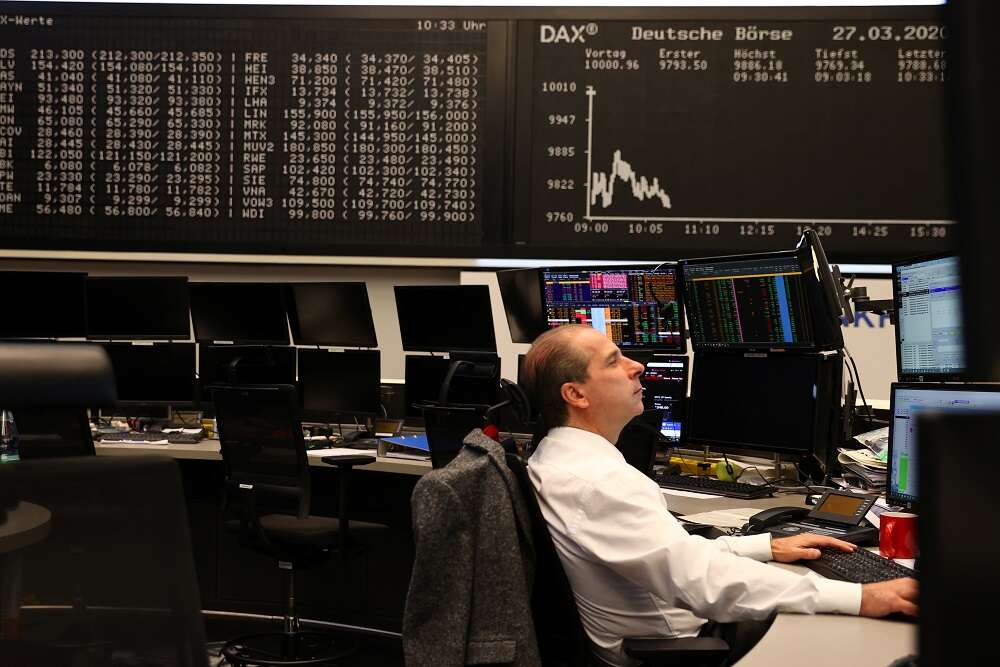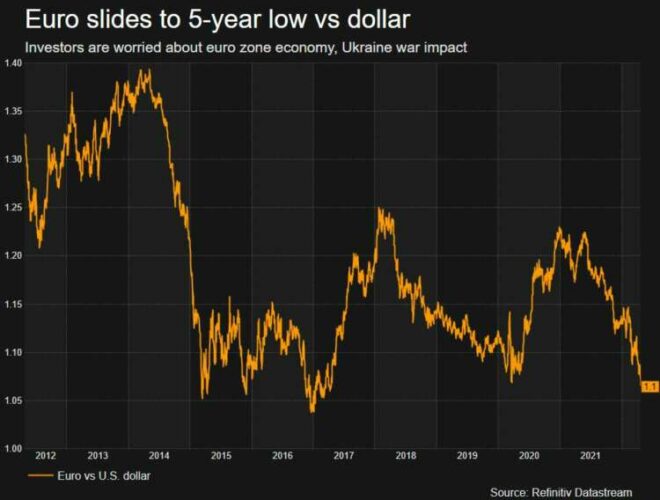
By Chris Prentice and Tommy Wilkes
WASHINGTON/LONDON (Reuters) – Major U.S. and European equity indexes rose in choppy trade on Wednesday, and the euro dropped to its weakest since 2017 after Russia halted gas supplies to Bulgaria and Poland and investors worried more about the region’s economy.
Wall Street rose, rebounding the day after a rout drove the Nasdaq to its lowest close since December 2020.
The dollar continued its surge, on course for its biggest monthly gain since January 2015 as expectations mounted that the Federal Reserve will hike interest rates aggressively in coming months and the U.S. economy will be stronger than the euro zone.
The Dow Jones Industrial Average rose 113.79 points, or 0.34%, to 33,353.97; the S&P 500 gained 24.36 points, or 0.58%, to 4,199.56; and the Nasdaq Composite added 77.51 points, or 0.62%, to 12,568.25 by 11:14 EST (1514 GMT).
Strong earnings reports boosted U.S. stocks, with Microsoft Corp jumping over 6% and Visa Inc surging over 8%.
Some of Wall Street’s biggest names have reported results this week, with investors seeking a counterweight to the deluge of negative news that has pounded stocks.
Google-parent Alphabet Inc fell 3.6% as slowing YouTube ad sales pushed quarterly revenue below expectations. Boeing Co dropped 8.8% after it disclosed $1.5 billion in abnormal costs from halting 777x production.
European shares rose, boosted by commodity stocks, though gains were limited as Russian energy giant Gazprom halted the gas supplies and German consumer morale sank. [.EU]
The Euro STOXX 600 was up 0.45%, while Germany’s DAX eased 0.04%. Britain’s FTSE 100 climbed 0.58%.
European corporate earnings were mixed. Credit Suisse reported another quarterly loss and Deutsche Bank warned the Russia-Ukraine conflict could hurt annual earnings.
Russia cut the gas flow to Bulgaria and Poland for rejecting its demand to pay in roubles, taking direct aim at European economies. This led investors to sell euros and snap up U.S. dollars.
MSCI’s benchmark for global equity markets rose 0.03% to 655.2. Emerging markets stocks fell 0.6%.
U.S. Treasury yields slid as data suggested trade dented economic growth last quarter and investors worries about the “restrictive” policy the Fed will pursue next week to combat inflation. [US/]
The U.S. trade deficit in goods widened to a record in March, the Commerce Department said. Trade has subtracted from gross domestic product growth for six straight quarters, the longest such stretch since the beginning of 2016.
The euro dropped as low as $1.0512, its weakest against the dollar since Mary 2017. Analysts cited the war in Ukraine and growing concerns that the bloc’s economy will fall into recession this year.
“The euro’s blatant inability to rally on hawkish comments by European Central Bank members means lingering vulnerability to an external environment negatively affected by an ever-concerning situation in Ukraine and generalized USD strength,” ING FX strategists wrote in a note to clients.
The dollar index measuring the greenback against a basket of rivals, hit a five-year high.
“The U.S. dollar benefits from the prospect of an ongoing flight to safety liquidity bid,” said Jeremy Stretch, head of G10 FX strategy at CIBC.

Graphic: Euro vs U.S. dollar – https://fingfx.thomsonreuters.com/gfx/mkt/zdpxogxldvx/euro%20dollar%202.PNG
CHINESE REBOUND
There was more selling in Asia, with MSCI’s broadest index of Asia-Pacific shares outside Japan down 0.82% after hitting its lowest since mid-March. Tokyo’s Nikkei fell 1.17%.
Australian shares lost 0.78% as inflation hit a 20-year high, bringing interest rate rises closer.
Battered Chinese stocks bucked the trend, gaining almost 3% as data showed faster profit growth at industrial firms in March than a year earlier.
The previous session, China stocks fell to their lowest in two years on fears that persistent COVID lockdowns would hurt economic activity and disrupt global supply chains.
Russia’s move to halt gas supplies to Poland and Bulgaria sent oil and gas prices higher, though not by much.
Brent crude futures were last up 0.12% to $105.12. U.S. West Texas Intermediate crude futures gained 0.13% to $101.57.
Elsewhere in commodities, spot gold prices fell 1.1%, under pressure from the stronger dollar. [GOL/]
(Additional reporting by Kanupriya Kapoor and Joice Alves; Editing by John Stonestreet, Mark Heinrich and David Gregorio)


